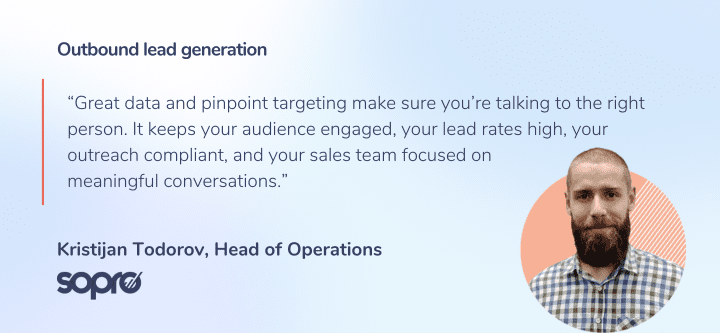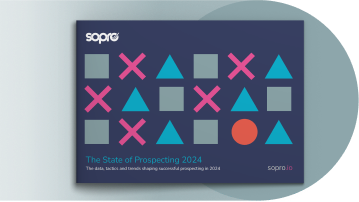What is outbound lead generation?
Table of content
- What are outbound leads?
- The traditional vs. modern approach
- Inbound vs outbound lead generation
- What are the benefits of outbound lead generation?
- Lead generation vs demand generation
- Outbound lead generation strategies
- The evolution of outbound lead generation
- How to be successful in your outbound lead generation

What outbound lead generation is, how it’s different from the inbound, and the outbound strategies every B2B marketer can adopt to start getting more leads.
Outbound lead generation involves proactively contacting potential customers who haven’t yet expressed an interest in your business. You aim to generate leads through outbound sales strategies, such as cold email outreach, cold calling, direct mail, and social media. It’s a great way to attract customers who might not already know about your product or service but are a great fit for your product or service.
The key to successful outbound sales lead generation services is reaching the right people with the right message at the right time and place. Knowing your audience and employing the right outbound sales and marketing strategies is key.
What are outbound leads?
Outbound leads are prospective customers who have entered into your sales funnel via outbound channels. In most companies, it is your sales reps that will have made the initial contact with the lead.
There are two different types of outbound leads:
- A Marketing Qualified Lead (MQL) is a prospect that may convert but isn’t ready to buy yet.
- Sales Qualified Leads (SQL) are further along the sales funnel and have indicated they are ready to buy.
Find out more about outbound leads and how they differ: Why your MQLs and your SQLs are not EQL.
The traditional vs. modern approach
Outbound marketing has undergone a remarkable evolution, transforming from an unsophisticated, mass broadcast approach into a collection of highly targeted, coordinated, and intelligent outreach strategies.
It used to mean casting a wide net and hoping that among the catch were enough people with an interest in your products. From direct mails to cold calling, mass email blasts to TV advertising, outbound prospecting used to be untargeted and unpersonalised.
Now, advanced data systems, hyper-personalisation, intelligent delivery platforms, coordinated multi-channel outreach, CRM integrations, and AI-driven advances combine to deliver an exceptionally effective form of lead generation.
Marketers can tailor their messages to the specific needs, goals, and pain points of their prospects. This shift improves the efficiency and effectiveness of campaigns, and fosters a more engaging experience for prospects.
Outbound marketing now stands as a sophisticated blend of art and science, enabling businesses to reach the right people, with the right message, at the right time.

Inbound vs outbound lead generation
The key difference in inbound vs outbound leads is that inbound leads have come to you – either for more information or because they’re ready to purchase.
Inbound lead generation strategies focus on getting people to visit your website or reach out to your sales teams. This is usually executed with SEO, blog posts, social media and email newsletters.
Outbound lead generation focuses on reaching out to potential customers.
Inbound and outbound leads are two sides of the same coin, one pushing and one pulling. Using a mix of both methods is the most effective way to bring about effective B2B lead generation.
Find out more with our ultimate guide to B2B lead generation.
Or, discover more about the differences between inbound and outbound marketing in our guide: Inbound vs Outbound Marketing.
What are the benefits of outbound lead generation?
In our recent survey of B2B leaders, the most significant challenges identified were generating enough leads, and ensuring the quality of leads.
While proactive outreach can address these issues quickly and directly, there is a broard range of benefits that can elevate your business development strategy.
Precision targeting
- Directly reach prospects fitting your ideal customer profile.
- Good targeting increases your engagement and conversion rates.

State of Prospecting 2024 research
Two-thirds of respondents agree that prospecting allows you to contact decision-makers that other methods struggle to reach.
Enhanced brand awareness
- Raise company visibility among your specific audience.
- Target prospects who have not been exposed to your inbound methods.
Explore new markets
- Find and engage prospects in new geographic or demographic segments.
- Tests the waters for product expansion with minimal risk.

State of Prospecting 2024 research
73% of B2B professionals agree that prospecting is a powerful tool for exploring new segments within their markets.
Personalised multi-channel outreach
- Tailor messages to resonate with specific segments and personas.
- Build stronger, more memorable, and more meaningful connections.
Understand your audience
- Gather direct feedback from prospects during outreach efforts.
- Enhance market intelligence by identifying trends, needs, and preferences within the target audience.

State of Prospecting 2024 research
72% of companies say prospecting significantly enhances their understanding of customer profiles and target markets.
Accelerated sales process
- Proactive contact shortens the sales cycle by initiating conversations, and ensures a consistent flow of leads.
- Flexibility to adjust strategies based on feedback and results.
Comprehensive marketing strategy
- Complements inbound efforts for a well-rounded approach.
- Maximizes reach and conversion across various customer segments.
| 84% of businesses agreed that using both inbound and outbound was best for their company. |
Lead generation vs demand generation
Lead gen and demand gen sound like the same thing, right? And they both help you generate leads. But there is a difference.
- Lead generation focuses on identifying prospects to help turn them into customers, focusing on pain points and benefits
- Demand generation is a broader strategy focused on creating demand for your product or service
In other words, demand generation tells people, “this could be a problem for you”, and lead generation says, “we have the solution to that problem”.
To take your strategy to the next level, you need to work with an expert demand generation agency, like Sopro.
Outbound lead generation strategies
29% of marketers we spoke to said they associated the term “lead generation” with companies that use high-volume, spammy tactics. But much like Marmite, it’s divisive… 71% said “lead generation” referred to any tactics used to generate leads, and everyone wants leads, right?
So, let’s look at some outbound lead generation strategies.
Email marketing
67% of B2B buyers said they actually liked email outreach more than any other channel. That’s why we think email prospecting is so essential to outbound marketing. But it only works if it’s done right.
The key to good email outreach is a great B2B database and knowing and understanding your target audience. A thorough, up-to-date database of B2B contacts from your target audience means you’ll only contact people who would be interested in what you offer (also important for GDPR compliance). It also helps make your messages personalised and relevant.
This makes the difference between spammy, mass emails and sending out good-quality cold emails to people who actually want to read them. It’s also a good idea to make note of the changes implemented by Gmail and Yahoo, which could also impact this.
Here at Sopro, we’re experts in email prospecting and how to target qualified leads, using advanced personalisation that makes every email feel like it’s 121.
Our email marketing agency uses advanced technology, diverse data sources, and a customised approach.
We ensure accurate, up-to-date, and compliant prospecting lists. Our expertise targets your audience, maximising campaign effectiveness and compliance with data protection laws. Get the inside track and some invaluable tips in our email marketing for lead generation strategies guide.
Cold calling
With new generations less and less likely to even answer their phone, is cold calling just a big waste of time?
Our survey found that less than 20% of B2B sellers now use phone calls as a communication channel. While calls can be an excellent tool for salespeople to really shine and do their best selling, they’re not always effective. Just 2% of cold calls lead to demos or appointments. While it definitely has its place, it might be worth your teams increasing their efficiency with intent-based warm calls.
Warm calling
Using intent tracking lets you understand when and how prospective clients get information about your product or service. Imagine this, a contact from your prospecting list is checking out your product page – you can then call them up, reference their visit and offer answers to any questions they had.
And according to our data, this is much more successful than the cold-calling alternative. Sopro lead generation campaigns that implemented buyer intent tracking (with over 100 calls logged) saw 8% of warm calls resulting in a booked sales meeting.
Direct mail
Direct mail can be an option that many marketers forget about during the sales process. And it’s come a long way – it’s more than just a leaflet through a stranger’s door. Personalisation can be used to target specific decision-makers and companies.
In our most recent survey, direct mail has seen an uptake in use – the comeback king, if you will! 18% of buyers said they were happy to be contacted this way. That’s over double the previous year. So, we had to test it ourselves!
Sopro ran an internal campaign, that sent out personalised letters before reaching out via email. Buyers who received letters were 23% more likely to open that email compared to those who hadn’t received anything beforehand.
Social media and content marketing
Social media changed everything. You can access people in their homes at any time of day or night – it’s the best thing to happen in marketing since sliced bread, and it definitely beats climbing in their window at night with a marketing flyer and handing it to them while they’re relaxing on the sofa.
Now, you can set up a targeted ad that will pop up as they scroll through their friend’s holiday photos or watch funny TikToks.
There are many ways to utilise social media and content marketing beyond ads and PPC:
- Blogs, reports, whitepapers
- Videos and Youtube
- Social posts
All these can be combined. A mix of social media and content marketing can be just as important for successful outbound marketing as it is for inbound marketing.
One of the most common platforms for B2B outbound lead generation campaigns is LinkedIn. Although you could use any social platform, Facebook, Instagram, X or TikTok. You’ll find relevant business and contact information on LinkedIn, like job titles and company updates, perhaps even the best email address. This is great news for your lead generation data lists and for tracking buyer intent.
Networking
Events can be a great way to engage potential customers and get them into that sales pipeline. Whether setting up a stall at a conference or a networking event, getting your brand and face out there is important.
Networking can also lead to referrals – the pot of the gold at the rainbow. Word-of-mouth or referrals tend to be one of the most trusted forms of marketing. Though referrals would fall under the umbrella of inbound marketing, they can still come from outbound marketing methods.
The future of outbound lead generation is poised at the exciting intersection of technology and personalized communication, where the lines between digital efficiency and human touch blur to create more meaningful connections with potential customers. Here’s a glimpse into what lies ahead:
The evolution of outbound lead generation
The evolution of outbound lead generation is marked by an increasing emphasis on creating genuine value for the prospect, moving beyond transactional interactions.
The future is about leveraging technology not to replace the human element, but to enhance it, making every outreach effort more relevant, timely, and compelling.
As we move forward, the success of outbound lead generation will hinge on the ability to blend innovative technologies with deep empathy and understanding of customer needs, crafting experiences that resonate on a personal level and drive meaningful engagement.
Integration of AI
Artificial intelligence is set to revolutionise outbound lead generation by enabling more sophisticated targeting and personalisation. AI can analyse customer behaviour, optimise outreach timing, and tailor messages to individual preferences, making each interaction significantly more impactful.
Personalised video messages
Video content has been gaining traction for its ability to convey messages in a more engaging and personal manner. In the future, we can expect a surge in personalised video messages as part of outbound strategies, where content is tailored to the viewer’s interests, challenges, and stage in the buying journey.
How to be successful in your outbound lead generation
So, what’s the takeaway?
Ancient methods have led “outbound” to be something of a dirty word, but with modern data, technology, and strategies, it is a highly targeted, relevant, and effective way to reach prospects and generate leads. We can help with that. At Sopro, our B2B lead generation service concentrates on sales engagement that focuses on connecting with the right people, at the right time, in the right place.







Share